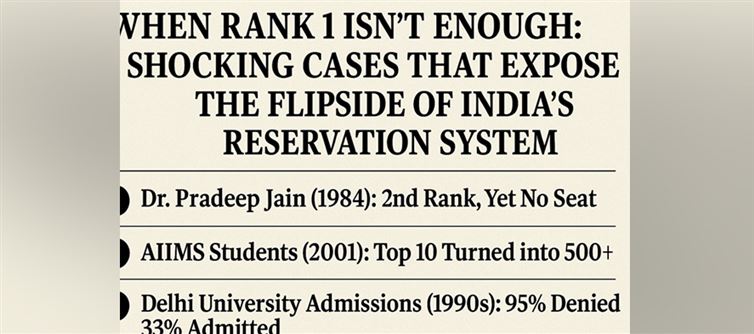
India’s reservation system was created to undo centuries of caste-based discrimination and uplift marginalized communities like SC/ST/OBC. While it has opened doors for millions, it has also thrown up some startling stories where even toppers and high-rankers found themselves sidelined. Here are three verified cases that shook the education system — straight from the records of the supreme Court.
1. Dr. pradeep Jain (1984): 2nd Rank, Yet No Seat
Dr. pradeep Jain stood 2nd in the BDS course at delhi University, a feat that should have guaranteed him a postgraduate medical seat.
Yet, due to domicile-based reservation, he was denied admission.
The case — Dr. pradeep Jain v. Union of India — remains one of the earliest and most powerful legal challenges against quota-related exclusions.
2. AIIMS students (2001): Top 10 Turned into 500+
Imagine being in the Top 10 of MBBS at India’s premier institute, only to be pushed down to a rank of 500-600 in postgraduate exams.
That’s exactly what happened at AIIMS due to institutional quotas.
The landmark case (A.I.I.M.S. Students’ Union v. A.I.I.M.S.) highlighted how internal reservations can erode merit even in elite institutions.
3. delhi University Admissions (1990s): 95% Denied, 33% Admitted
In the 1990s, shocking instances emerged from delhi University.
General category students with 95% marks were denied seats, while candidates from reserved categories were admitted with just 33-45%.
This led to the supreme court case State of mp v. Kumari Nivedita Jain, which exposed how steep the gap between categories could become.
The Bigger Picture
These cases are rare but telling. They don’t negate the social justice goals of the reservation — which have undeniably uplifted marginalized groups — but they do reveal cracks in the system. Critics argue that quotas should evolve to better target the most disadvantaged, without alienating deserving toppers.




 click and follow Indiaherald WhatsApp channel
click and follow Indiaherald WhatsApp channel